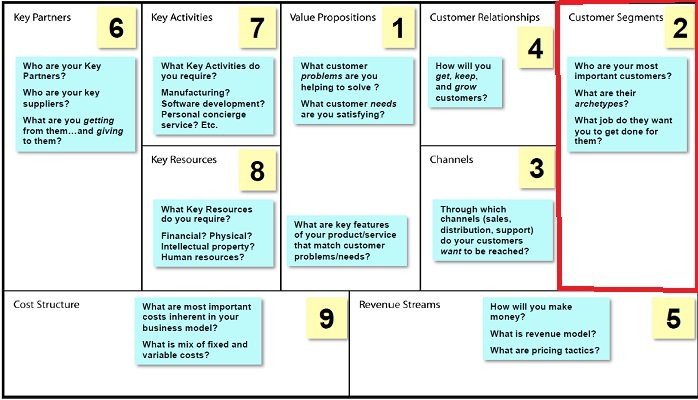
The Customer Segment is one of the most important building blocks in the Business Model Canvas, so getting this right is key to your success. By matching your customer segment to your value proposition, you can achieve a more lucrative revenue stream and develop a Product Market Fit (briefly discussed in last week’s article). This part of the BMC can only be done outside of the building by interviewing hundreds of potential clients. Your customers can be segmented into different groups based on their needs, behaviors, and other traits they share. A customer segment can also be defined through demographics such as age, ethnicity, profession, gender, and more. We can also break this down into other factors such as spending behavior, interests, and motivations. Then, the organization must create a value proposition, and employ a business model best suited to servicing their chosen Customer Segment’s needs.
The Customer Segment part of the Business Model Canvas will help the startup discover the following:
Creating a Customer Profile:
Who Is My Archetype? In order to ensure that a start-up’s product or service appeals to its customer segment, the business must work to understand who the customer really is. This can be discovered by evaluating the customer’s environment, experiences, and general social context. This is called “living in the day and life of your customer.” By learning what your customer does from the minute they wake up until they go to sleep, you come to understand exactly where your product fits in their lives. All of these factors contribute to how the customer will respond to your product. So, a customer’s geographic, demographic, and social context will define the customer’s persona, creating a customer archetype for your products and services.
Customer Gains. We have to ask ourselves what outcomes our clients expect, and then widen our lens to discover what we can provide for them that would go beyond their expectations. Is it quality they are looking for, or more of “this” and less of “that?” Could it be features they are looking for, or perhaps better performance? What would make your customer’s job or life easier? Could it be more services, lower cost of ownership, or removing a step from a cumbersome process? And what would increase the likelihood of them purchasing your product or service? Is it cost, better quality, lower risk, more fun? The answers will differ if you are selling to a business customer rather than a consumer customer, but regardless of your customer type, these questions all need to be answered in the Customer Segment of the BMC.
Customer Pains. This part is the part that is easiest to identify. It’s seeing clearly what exactly is causing your customer hardship, and making sure your product or service will alleviate it.
Customer in Context. Selling a product or service from business to business is much different than selling to a consumer or end user. Within a corporation there will be people who use the product, people who would recommend the product, and people who are the actual buyers of the product. But the people you really have to look out for are the saboteurs. A great example of this is when one of my companies, Bisenti Technology (www.bisentitech.com), went for its first big project with one of the largest Hedge Funds in America. We knew who the economic buyer was (the CFO), we knew who the end user was (the marketing and sales departments), but we had to understand that the I.T. department was going to be our saboteur. They were worried that we were going to take their jobs instead of understanding we were there to help them. Knowing the chart of players before going in gave me a strategic move that helped us win the contract.
With all of this information in place, it is time to hit the streets and start testing your hypothesis. I ask myself the following questions as I engage in this real-life stage of the Customer Segment:
How do you test your customers’ interest? I use what is called a Minimal Viable Product (MVP). This contains the core features your product or service delivers. I watch the customer’s eyes as they review my solution to their long-standing problem. If they light up, I know I am in. If not, I ask questions and iterate.
Where do you test your interest? When I started Credit Justice Services (www.creditjusticeservices.com), I went to over 100 mortgage broker offices with my MVP, showing them the solution I had to their problem. When I started Bella’s, a new chain of restaurants (www.bellas-restaurant.com), I placed a picnic table in the middle of a defunct restaurant, and cooked for 15 people every day for six weeks until I knew I had the recipes just right.
What kind of experiments can you run? I try to keep it as simple as possible. When I came up with a new Italian red sauce at my restaurant, Bella’s, I tested 500 people who sat at my bar and did a blind taste-test with 10 other red sauces. This gave me enough data to figure out what I needed to do to be number one.
How many do you test? This is simple. The larger the data set you have, the more the accurate information about your product or service will be. I try to never to go below 100 users.
For more information about starting a company or new product development, please feel free to contact me at dmuir@muirandassociates.net
Source:
Blanks, S. (n.d.). (2015, November 13). Business Model Canvas, Udacity. Retrieved from www.udacity.com

